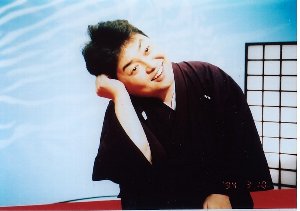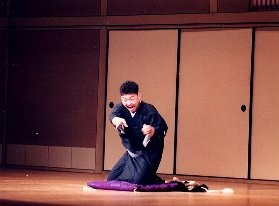Traditional Japanese Comedy Performed in Sign Language (March 2004)
Compiled and translated by the Japanese Society for Rehabilitation of Persons with Disabilities (JSRPD)
"Rakugo", a Japanese sit-down style of comic story telling, is one aspect of the traditional culture that has been verbally passed down through generations. The performer in Japanese traditional formal clothes (kimono) sits on his knees on a cushion (zabuton), tells comic stories using a fan (sensu) and a hand towel (tenugui). It could be considered similar to black humor or a comedy if it were performed in other languages.
Traditional performances adapted in sign language

The "Rakugoka" or performer is always studying how he can make an audience laugh and so is Deaf Ippuku, who became the first professional Rakugoka with a hearing disability. Ippuku performs Rakugo using sign language and contributes to the deaf culture that people with hearing disability can enjoy. Rakugo was first performed in sign language around 1979 when a professional Rakugoka called Mr. Katura Fukudanji hurt his throat and lost his voice temporarily. At that time, just by chance, he saw people using sign language. He learned about sign language and started to use it to perform Rakugo. Ippuku became the pupil of Mr. Katsura Fukudannji, one of the originators of Sign Language Rakugo, in 1980.
While practicing performing Rakugo, Ippuku noticed that a story just interpreted from the original Rakugo into sign language did not attract the deaf audience. Such a story could not make them laugh. There is often a difference between what is considered funny in deaf culture and other cultures. Therefore in order to make deaf people laugh, the original story should be adapted. Ippuku studied hard with his deaf colleagues, consulted with his master, and adapted the original story a little to be more suitable for the deaf audience. For example, he included topics that were more familiar to the deaf people and also had a deaf person as a main character of a story. Thus he began to create his own Rakugo to be performed in sign language. He was always thinking, "Sign Language Rakugo can become the deaf culture in a true sense, only when we can make deaf people laugh." Such efforts were recognized and he was promoted to be a professional Rakugoka with hearing disability for the first time in Japan. He changed his stage name to "Deaf" Ippuku and left his master in 2001.
Sign language Rakugo grows during 1980s

In 1980s, sign language was prevailing in Japan and groups of people learning sign language were being established one after another all over the country. In such a situation, Sign Language Rakugo also drew a great deal of attention. Ippuku gave 70 to 80 performances in a year in his heyday and spent very busy days as an active performer. In 1991 he performed Sign Language Rakugo at the World Congress of the World Federation of the Deaf held in Tokyo and attracted people from all over the world. He was highly appreciated, as "Rakugo is a culture that has a real Japanese taste and since it is performed in sign language, it means that Japan has a true deaf culture, which is wonderful." This gave Ippuku a strong self-confidence. Besides, he was asked and actually started to visit overseas to perform Sign Language Rakugo. So far he performed at the congress and festival of the Deaf in Italy, the United States, the United Kingdom and so on, and now performs one or two overseas performances a year.
As for the domestic performances, he appears in Rakugo programs all over the country. These opportunities are usually given by his friends and acquaintances. However, as the Japanese economic conditions deteriorated, the requests for him to perform Sign Language Rakugo have decreased to around 50 a year since about 5 years ago. There are no sponsors or cooperators so the financial situation is quite severe.
Number now decreasing
At present, about 30 people are actively performing Sign Language Rakugo and around 25 of them are deaf, while about 5 have difficulty in hearing. The number is decreasing, as they get older, though there used to be about 50 performers. Ippuku has 5 pupils now who perform in many places around the country. They mainly perform for the sign language learning circles by attending various events such as Christmas parties.
Examples of comic stories
Here are a few comic stories.
Love affair of the Statue of Libert
As you know, Miss Liberty lives in New York in the United States. She has no boyfriend and asked me to introduce someone very nice. I said, "OK. In Japan, a very big man called Daibutsu-sama--the giant statue of Buddha--lives in Nara. Let me introduce him to you." Daibutsu-sama immediately left from Nara and swam across the Pacific Ocean to see Miss Liberty and they started dating.
A Mole of Daibutsu
Daibutsu-sama in Japan has a very big mole on his forehead. I asked him, "How did you come to have such a mole?" He said, "Once I went to see my sweetheart, Miss Liberty in America, and kissed her when we said goodbye. Just then the sharp edge of her crown hit my forehead and hurt it very seriously. That scar has become a mole."
Ippuku never forgets to pay attention to people with other disabilities. In order to get more profound understanding of people with disabilities, he includes stories about troubles that the blind, the people in wheel chairs and the parents of people with intellectual disabilities experience, to his original modern Rakugo (which he creates himself getting the idea from daily life and topics familiar to everyone). For instance, he made up a story after meeting with Mother Teresa. When they first met, she began talking to Ippuku very excitedly and seemed to be complaining about something. Ippuku tried to understand what she said, "Why don't the Japanese help people in wheel chairs, when there is no elevator and they are in trouble. Japanese people are so unkind." Ippuku felt that it was the shame of Japan and since then he has been talking about this in his Rakugo so that the Japanese will understand more about disabled persons and how they can help them.
Adapting to each audience
When Ippuku receives a request to perform Rakugo, the first thing he asks is who the target audience is. Are they all deaf? Or are there any people with hearing difficulty that do not understand sign language? Or are the blind people included in the audience? According to the situation, the preparation of the hall, reference materials and even the story to be performed will be adapted. He prepares audio equipment to read out sign language, OHP to show captions and reference materials in Braille, depending on the needs of the audience. It takes time and is quite difficult to make reference materials and prepare everything necessary, but if he declined a request to perform Rakugo for such people with disabilities, he thought it would mean discrimination. The same is true of the overseas performances. He has his Rakugo interpreted first to American Sign Language, again to German sign language and then finally to German speech. As in the World Congress of the World Federation of the Deaf, he makes sure that everyone can understand through many interpreters.
Ippuku wishes to keep sending various messages to the world through Sign Language Rakugo.
Full text is available online at:../resource/rakugo.html
Ippuku Homepage (Only Japanese):
http://www02.so-net.ne.jp/~suzusige/nakayama.html
Contact:
Deaf Ippuku Office
FAX: 072-264-7082
Phone: 072-262-7168
Email: shinji-777@mse.biglobe.ne.jp
